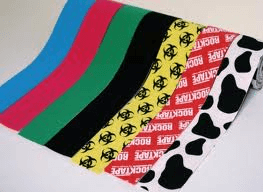What’s with the Rainbow Tape? Dynamic Taping Explained
Athletes participating in a range of sports have been covering their bodies with tape in a multitude of colours over the last few years. What is the science behind this rainbow tape and how can it help your recovery?
The idea behind elastic taping (also known as dynamic or kinesio taping) is for it to mimic the qualities of human skin. The main advantage of elastic taping is the wearer is able to move without restriction whilst wearing the tape. It is latex free, which allows for longer wear period and can be stretched to varying degrees.
The cut of the tape, direction of application and amount of stretch is altered depending on the individualised assessment and diagnosis of injury by the physiotherapist. Elastic taping is largely applied to either facilitate or inhibit a particular muscle’s action, it is thought to largely work through the activation of sensory receptors through the skin.

It has been found in some small studies on the neck and shoulder region to reduce pain and improve range of movement, however as yet there have been no gold standard trials run on its efficacy.
The main thing for wearers to remember is the tape is not “magical” and should not replace proper injury rehabilitation. It is best used in combination with other treatment techniques such as manual therapy, massage and proper strength and conditioning of the appropriate area. However elastic taping may be useful in the early reintroduction to activities of daily living or sport, reducing pain and increasing confidence, to help prolong the effects of a treatment session.
If you would like to know more about elastic taping or trial it at your next treatment feel free to ask your physiotherapist.
[/fusion_text][/fusion_builder_column][/fusion_builder_row][/fusion_builder_container]



